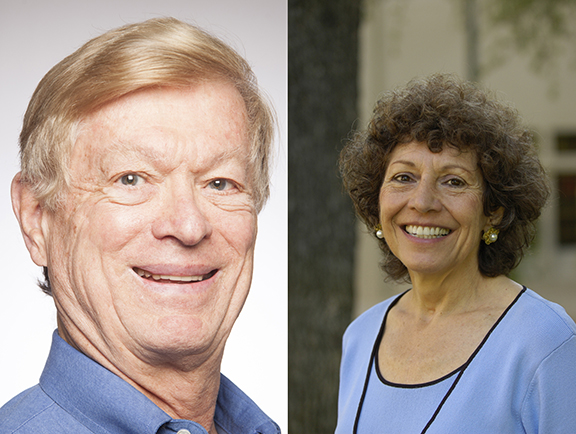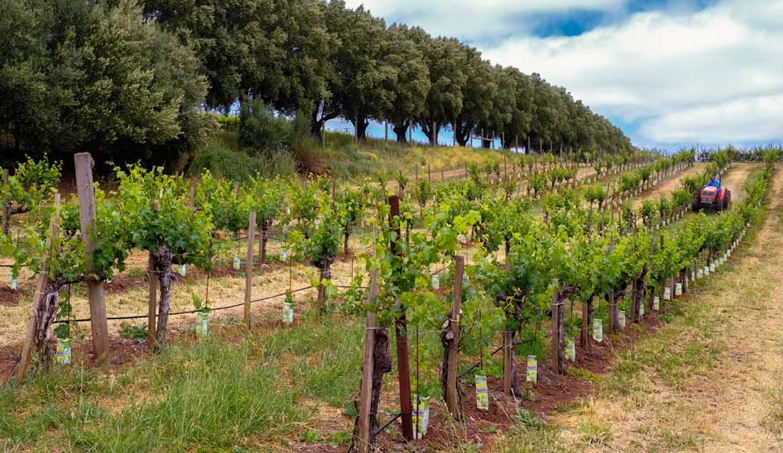
(Working at the Dunn Vineyards farm)
Précis. Drs. Lucia and John Gilbert share the generational transition stories of six iconic family-owned Napa Valley wineries, Buehler Vineyards, Corison Winery, Dunn Vineyards, Philip Togni Vineyard, Storybook Mountain Vineyards, and VIADER and offer their own insights and reflections.
Napa: Behind the Bottle (2008), a well-known book of photographs by Bill Tucker, depicts the owners and winemakers of Napa's iconic family-owned wineries and vineyards at the end of the 20th century. Many of these wineries are now owned by other entities and not the original families. Moreover, there is considerable concern that the remaining independently-owned small family wineries may not have a future in Napa, given the influx of corporate and private money, and the further consolidation of the wine industry that is afoot.1
 (Partial map of Napa Valley)
(Partial map of Napa Valley)In light of these changes and concerns, we identified six of Napa's iconic family-owned wineries and vineyards established in the 1970s and 1980s that have significant next-generation involvement. We sent an invitation to the founding owners and their children asking them to participate in a conversation about their "Generational Transition," and the career paths of the children who have become involved. We also asked their advice for those who might be considering a generational transition.
We felt privileged to meet in-person with all six founding owners, who ranged in age from the early sixties to the late nineties, and members of their families. The conversations were lively, enlightening, and heartfelt.
We share insights and reflections from conversations with these six families, and include the year they established their winery in parentheses: Buehler Vineyards (1978), Corison Winery (1987), Dunn Vineyards (1979), Philip Togni Vineyard (1983), Storybook Mountain Vineyards (1976), VIADER (1986). The map depicts the approximate location of each winery.
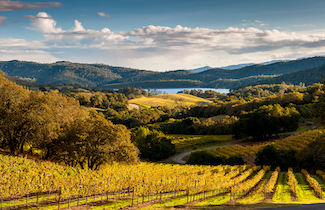 John Buehler Jr., Buehler Vineyards (St. Helena)
John Buehler Jr., Buehler Vineyards (St. Helena)"All four of my children are involved, it is in their DNA." John Buehler Jr.
Buehler Vineyards is a beautiful 300-acre hillside property nestled in the mountains above Conn Valley, overlooking Lake Hennessey and not readily accessible. One needs to navigate both Howell Mountain Road and Conn Valley Road for several winding miles before continuing for a few more miles on Greenfield Road, a narrow and also winding pathway with few markings. Once there, you are rewarded with a spectacular view.
(Vista from Buehler Vineyards)
John Buehler Jr., greeted us warmly after our long trek and noted that "the Buehlers live on the property and value their privacy." He built his home there in 1975.
 In 1971, John Buehler Sr., an executive of Bechtel Corporation, purchased the land for retirement, and John Jr., then in his early 20s, "who had made a commitment to the land," pursued his dream of becoming a viticulturist. Having recently graduated from college, he worked with his father to renovate the property. After six years of growing and selling top-quality Cabernet Sauvignon and Zinfandel, they oversaw construction of a winery on the property and began making wine in 1978.
In 1971, John Buehler Sr., an executive of Bechtel Corporation, purchased the land for retirement, and John Jr., then in his early 20s, "who had made a commitment to the land," pursued his dream of becoming a viticulturist. Having recently graduated from college, he worked with his father to renovate the property. After six years of growing and selling top-quality Cabernet Sauvignon and Zinfandel, they oversaw construction of a winery on the property and began making wine in 1978. John Jr. was the founding winemaker. He later recruited his replacement, UC Davis graduate David Cronin, then at Far Niente, who is now their long-time and esteemed winemaker. Buehler Vineyards farms organically and has a production of 3500 cases. Not unlike other wineries in relatively remote locations, the family handles all the vineyard management, winemaking, and even bottling. In short, the winery is completely self-contained in that it manages winemaking operations from vine to bottle, what is referred to as a vertically integrated winery, an unusual model for many of the wineries in the Napa Valley.
John's love for what he does was palpable. He provided an informative and enjoyable tour of the excellent facilities and vineyards. Known for its estate-grown Cabernet Sauvignon and Napa Valley Zinfandel, Buehler also produces a Chardonnay from fruit sourced from vineyards in the Russian River Valley. Critics and reviewers have noted that Buehler wines prove that elegant, age-worthy, classic wines from the Napa Valley can be purchased for a very reasonable cost. In 2022, Wine Spectator, for example, included the Buehler 2019 Cabernet among "the 8 stunning Napa Cabs" priced $50 or less." Having a reasonably-priced wine is an important goal for John and his family.
The Family and Its Generational Transitions. John Jr., the second-generation owner, oversees the entire day-to-day operation at Buehler, all the way from vineyard management to production to marketing, represents the winery to the public and trade and industry groups, and is responsible for long-term planning and strategy. All four of his children are college graduates, and fluent in Spanish. After some period of time spent away, all have returned to the roost, hold paid positions, and are part-owners.
John attributes his children's involvement to their growing up loving the land, seeing the family working in the vineyards, having close relationships with their grandparents who also lived on the estate, and their DNA. "Their connection is more about farming than wine." He says he never pressured any of his children to participate, and gave them room to find their own passions.
His youngest child, Jonathan, now 35, is the general manager, and his oldest child, Page, now 45, can be found working in the vineyards and in the cellar. Lindsay, the second oldest child, is secretary of the family's corporation. A fourth child, Helen, has traveled extensively in Europe, and had worked in sales before accepting a position at Buehler Vineyards in social media and sales. John is hopeful that there will be a transition to a fourth generation, as his grandchildren are also growing up on the land.
Considerations in Planning for a Generational Transition. John is concerned that "Napa natives are becoming an endangered species," and that the area is becoming a magnet "for rich and famous commerce families." His advice for those wanting to pass on their vineyards to their children is to instill in them a sense of place and pride in the land, and to manage finances wisely.
Cathy Corison and daughter Grace Corison Martin, Corison Winery (St. Helena)
"This is a really a tough business. You have to be passionate, prepared, and a little bit crazy." Cathy Corison
Cathy Corison of Corison Winery is a person of great vision and determination. She crafted the first vintage of Corison Cabernet Sauvignon in 1987, establishing her own label and becoming the first female winemaker/proprietor in the Napa Valley.
When she graduated with her undergraduate degree in biology from Pomona College in 1975, she knew that using science and crafting wine were her calling. She drove directly north to Napa without a job but with all of $200 from her father in her pocket. She put herself through UC Davis working half time, completing her Master's degree in enology in 1978, and then accepting a harvest internship at Freemark Abbey that same year. In 1979, she held her first winemaking position at Yverdon, a small-production winery. Then she moved on to Chappellet Winery in 1980 as its winemaker.
In 1987, toward the end of her tenure at Chappellet, "I felt that there was a wine inside me that needed to get out" and needed to find a way to make this wine. She began to buy grapes and barrels and used other wineries' excess capacity to craft and store her wine. The result was the aforementioned and now highly acclaimed Corison Cabernet Sauvignon. To help cover costs at the time, Cathy continued to moonlight as a winemaker at Staglin Family Vineyard and Long Meadow Ranch Winery.
The family purchased the Kronos Vineyard, a property that had been a farm for over a century, in 1995, and a few years later built a winery on it. They purchased a second estate vineyard, Sunbasket, in 2015. Both vineyards are certified as organic. In addition to its well-known Cabernets, Corison also crafts Cabernet Franc, Gewürztraminer, and Riesling.
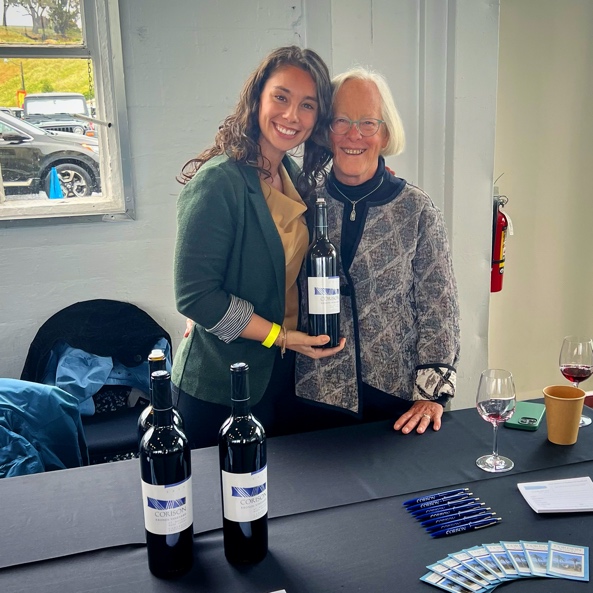 Cathy has received world-wide acclaim as a winemaker. This includes her being named the San Francisco Chronicle's 2011 Winemaker of the Year, receiving high praise from Eric Asimov, the wine critic for the NY Times, and Corison Winery being included in Wine and Spirits Magazine. "Top 100 Wineries" in the world.
Cathy has received world-wide acclaim as a winemaker. This includes her being named the San Francisco Chronicle's 2011 Winemaker of the Year, receiving high praise from Eric Asimov, the wine critic for the NY Times, and Corison Winery being included in Wine and Spirits Magazine. "Top 100 Wineries" in the world.(Cathy and Grace)
The Family and Its Generational Transition. Although the Corison name is on the label, Corison is clearly a family winery. Cathy's husband, William Martin, is involved full time. An architect by training, he designed the structure that has housed the winery and tasting room since 1999. They have two children, Grace and Rose, now in their late 20s and early 30s, respectively. Rose, their older daughter, has a degree in engineering, and Grace, a BFA in acting. When asked about a possible generational transition, Cathy said that they "always hoped their children would carry the business forward, but wanted them to find their own way back."
Cathy shared that the general topic of second-generation involvement first came up in the summer of 2019. Their two daughters were living in NYC at the time and weren't thinking about a future in the wine industry. On a visit to NYC a few months later, William directly raised the issue of the future of the winery. He noted that Cathy and he would make different business decisions if Rose and Grace did not come back to the winery and asked if they were interested in joining the winery. The ask was gentle and open, with no specific commitment. To their surprise and joy, both daughters expressed interest. At the time, Grace was studying wine and learning how the Napa Valley fit into the world of wine.
Then came the pandemic, prompting both daughters to return home and become involved in the winery. Grace, who has now been full time since 2020, said "she was fortunate to be able to work in all areas of the winery, from vineyards and winemaking to hospitality to bookkeeping. It was all hands-on-deck." She continued, "As part of the family, no one is going to have the same investment or passion for our project as I will." Since being on board, Grace accomplished getting the vineyards certified as organic (CCOF), and is heading up qualifying for Napa Green Winery and Vineyard certifications.
Grace has completed her Level 3 Advanced Certification from the Wine & Spirit Education Trust and the UC Davis Winemaking Certificate Program. Looking towards what the transition will look like, both Cathy and Grace believe that the next generation will need agency at a certain point. Cathy envisions taking on more of an advisory role with time. Grace's older sister Rose is currently enrolled in the UC Davis Winemaking Certificate Program and hopes to be more involved down the road.
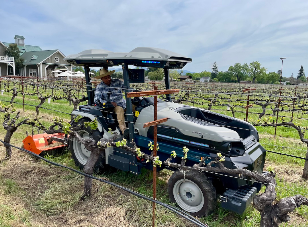 A recent mother-daughters visit to family-owned wineries in Germany had a big impact on both daughters. Perhaps most poignant was learning about the evolution of the wineries there and the significant importance and value of generational continuity.
A recent mother-daughters visit to family-owned wineries in Germany had a big impact on both daughters. Perhaps most poignant was learning about the evolution of the wineries there and the significant importance and value of generational continuity. (Electric tractor powered by Corison Winery solar panels)
Considerations in Planning for a Generational Transition. Cathy believes that the family is in a fortunate position. It has a long history of producing quality wine, owns two vineyards, has engaged in good financial planning, has good parent-daughter relationships, and loves what it does.
She also noted serious challenges to consider when entering into a generational transition. These include the increasing consolidation of the industry, high land prices, the rising cost of farming, and legal issues around inheritance. Grace added climate change as a challenge, which she sees as her own generation's problem. One of her priorities is to look at their business from a sustainability perspective through the Napa Green and CCOF certifications.
Cathy is actively involved in organizations and initiatives attempting to ensure a place for the next generation of small family wineries. She is on the board of directors at Napa Valley Grapegrowers and has long championed sustainability in both vineyards and wineries.
Randy Dunn, son Mike, and daughter Kristina Dunn-Buchanan, Dunn Vineyards (Howell Mountain)
"We farm 42 acres of Cabernet Sauvignon on Howell Mountain. Since 1979, we've done our best to care for these vines so that they produce a wine that tastes like Cabernet Sauvignon from Howell Mountain. Today we are hands-on in the vineyard, on the crush pad, and in the cellar. Any more land and we would need to spend more time administering and managing. We'd prefer to farm." Randy Dunn
Dunn Vineyards is located far up Howell Mountain in the northeast quadrant of the Napa Valley. It is near the village of Angwin, in the Vaca Mountain range that lines the east side of the valley. The long drive through this beautiful, rugged country gave us a glimpse of understanding the powerful attraction of Howell Mountain to winemaking pioneer Randy Dunn. When we arrived, we knew from the equipment (including an old fire truck) and seeing Randy getting off his tractor, that we were at a working farm.
Randy Dunn graduated from UC Davis in 1975 with a doctoral degree in Entomology with a focus on enology. A 10-year association with Caymus Vineyards began soon thereafter. With the assistance of the Caymus family, Randy and his spouse Lori bought and revived an old 5-acre Cabernet vineyard on Howell Mountain in 1978, and produced their first vintage the following year. Randy continued to do consulting for several years, allowing the Dunns to solely focus on their own winery by 1993.
Today, the family organically farms about 42 acres of vines on Howell Mountain, at altitudes ranging from 1,800 to 2,200 feet, safely above the fog line. Its two flagship wines are a Howell Mountain Cabernet Sauvignon and a Napa Valley Cabernet Sauvignon, both 100% varietal wines. Production is about 5,000 cases annually.
Randy's reputation for being a renegade in the wine world is reflected in the fact that he has consistently kept the alcohol percentage of his wines lower than other vintners, typically in the mid- to high-13% range. He crafts his wines to last.
Dunn's flagship Cabernet has been one of Napa Valley's slowest aging and most consistently outstanding wines. The Dunn Cabernet Sauvignon Howell Mountain 2019 was top rated by Wine Spectator and included among its top 10 wines for 2023. When Antonio Galloni hosted the inaugural edition of Napa in the City in 2022, he included "A fabulous vertical tasting of Dunn's Cabernet Sauvignon Howell Mountain . . . back to 1985."
The Family and Its Generational Transitions. We met in the Dunn's first home on their property, sitting around the kitchen table; it now serves as the winery's tasting room and place for visitors. Joining us were Randy and his two children, Mike and Kristina. Dunn Vineyards is clearly a family operation and includes Randy's spouse Lori, and Mike's spouse Kara Pecota Dunn.
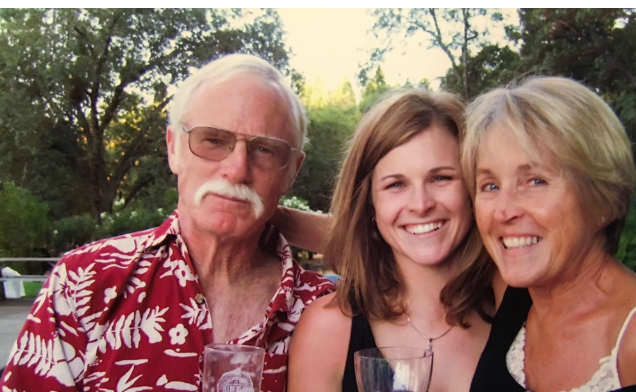 Mike, who has great positive energy, started the conversation, explaining that he grew up on the property and was involved with the vineyards as a youth. "Randy always kept us busy and involved—he has a great work ethic." Mike, an avid biker, started his own bike shop after graduating from UC Santa Barbara in 1988. One day, while reading a book on wine, he found himself "reading about my own family!" He called his dad and asked if he could come to work for him, but Randy responded that his children first needed "to be their own boss."
Mike, who has great positive energy, started the conversation, explaining that he grew up on the property and was involved with the vineyards as a youth. "Randy always kept us busy and involved—he has a great work ethic." Mike, an avid biker, started his own bike shop after graduating from UC Santa Barbara in 1988. One day, while reading a book on wine, he found himself "reading about my own family!" He called his dad and asked if he could come to work for him, but Randy responded that his children first needed "to be their own boss."(Kristina and her parents)
Mike pursued his successful business until he received a call in 1999 to come home. That year his 20-year-old younger sister Jennifer died unexpectedly of bacterial meningitis while attending college. The loss devastated the family. Mike came home, and, according to Kristina, who was 17 at the time, "Mike saved the winery." He saw what needed to be done and worked closely with his father. Kristina studied viticulture and enology in college and, after graduating, worked at Cardinale before creating a job for herself with the family estate, managing marketing and hospitality. By 2005, both Mike and Kristina were working full-time for the winery. To cite from the Dunn website, "It is safe to say, that we are who we are today because of the love Jenny brought to our lives."
Now in his seventies, Randy remains hands-on in the vineyards and in charge of the machinery repair. Mike handles the business end, oversees wine production, works with the vineyard team, and manages the overall operation. Kristina, who has two young children and a spouse who works long hours as a firefighter, has pulled back from her full-time work but is close at hand if needed. When asked what she most loved about her involvement as a next-generation family member, Kristina said, "the ability to evolve and grow; my family's willingness to give me the space to be involved." She is constantly in the loop, joins their regular meetings, and feels respected by the family for her decision.
Randy never pushed his children to be involved, but, as Mike noted, "seeing your parents working, that's important." Both siblings do what comes naturally for them as Randy and Lori's children and involve their own children in the farming. Kristina's daughters tour the vineyards eating wild blackberries (not the precious grapes!), testing grape ripeness, and riding the tractor with Uncle Mike or Grandpa Randy. Mike's son Alex, who has helped with bottling and worked in the vineyards over the years, joined the family operation full-time in 2023, making Dunn Vineyards a three-generation family business.
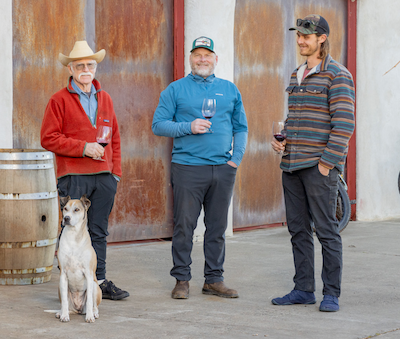 Toward the end of our conversation, Kristina brought up the topic of land conservation, and its importance to the Dunn family. In 2004, Randy and Lori gifted the development rights for their Sentinel Hill property, 64 acres of forested hillside on Howell Mountain, to the Napa Land Trust. The family also made a gift of $5 million, the largest donation in the history of the Land Trust, to help purchase the Wildlake Ranch, a 3000-acre property on the mountain where Randy and his late daughter often rode their horses. Randy showed some amusement in sharing this information as he never had had a loan and has lived frugally. "Now I am saddling my family with debt."
Toward the end of our conversation, Kristina brought up the topic of land conservation, and its importance to the Dunn family. In 2004, Randy and Lori gifted the development rights for their Sentinel Hill property, 64 acres of forested hillside on Howell Mountain, to the Napa Land Trust. The family also made a gift of $5 million, the largest donation in the history of the Land Trust, to help purchase the Wildlake Ranch, a 3000-acre property on the mountain where Randy and his late daughter often rode their horses. Randy showed some amusement in sharing this information as he never had had a loan and has lived frugally. "Now I am saddling my family with debt." (Randy with son Mike and grandson Alex, credit: Meg Smith)
Considerations in Planning for a Generational Transition. When asked what advice they would offer other families considering a generational transition, all three mentioned needing to deal effectively with the influx of big money coming into the area, putting tremendous pressure not only on the independently-owned family wineries but also on the wild lands above the valley floor.
Randy noted that "estate planning is hugely important as is finding legal ways of protecting things." He also believes strongly in letting your children see your own passion for farming and love for the land, encouraging their involvement with the land growing up, and giving them the space and tools to find their own path back home.
Philip Togni and daughter Lisa, Philip Togni Vineyard (St. Helena)
"It's rather un-American, the idea that you don't need to grow . . . The idea that if you start up a small wine operation you begin by building a tasting room—that's not our idea. But a vineyard is essential, for control and continuity." Philip Togni
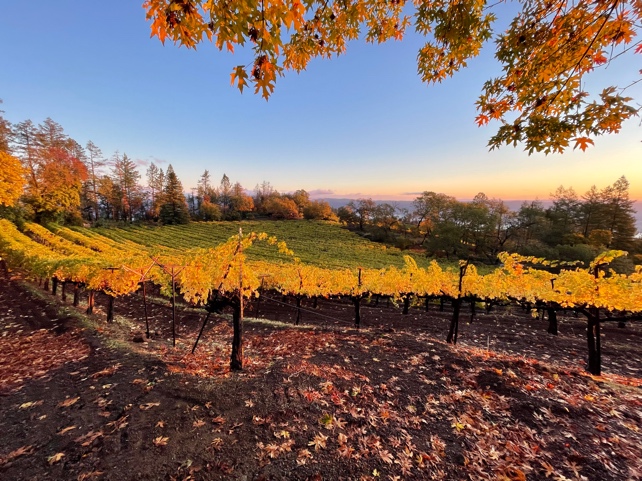 It was quite a drive to the remote Philip Togni Vineyard, tucked away down a dirt road in the hills of the Spring Mountain District outside of St. Helena. Our conversation took place in the front yard of Birgitta and Philip's home that overlooks a beautiful vista. Philip, now in his late 90s, was witty and engaging, and clearly admiring of his daughter Lisa, now the winemaker: "I could not think of anyone more qualified."
It was quite a drive to the remote Philip Togni Vineyard, tucked away down a dirt road in the hills of the Spring Mountain District outside of St. Helena. Our conversation took place in the front yard of Birgitta and Philip's home that overlooks a beautiful vista. Philip, now in his late 90s, was witty and engaging, and clearly admiring of his daughter Lisa, now the winemaker: "I could not think of anyone more qualified." (Togni Vineyard in the autumn)
When we turned to the topic for our conversation, Generational Transitions, Philip shared a cautionary "four barrels" tale about a friend and notable winemaker who tried too hard to get his children involved in his winery. His friend had brought up his four children to do various winery-related tasks that he had assigned. To symbolize their participation, the tasting room sign was four barrels of decreasing size—one for each child. Philip added that, "To my knowledge, not one of the four ever got involved in producing wine in later life." Learning from his friend's experience, Birgitta and Philip shared their secret of success—not to mention at all that Lisa should get involved in the vineyard or other operations at the winery!
Philip Togni (British born) was trained in geology but became more intrigued by wine after a visit to Spain's Jerez wine region while on leave from working at Shell Petroleum. He was introduced to the well-known UC Davis professor Maynard Amerine, on sabbatical in Spain at the time, who advised him to study enology. Philip followed his advice and became a student at Ecole Nationale d'Agriculture, Montpellier, and of Emile Peynaud at the University of Bordeaux, where he earned the Diplôme National d'Oenologie. He asked Amerine for advice a second time, in 1959, while working in Chile. Amerine encouraged Philip to visit California and to place a "want ad" in the Wine Institute Bulletin. Later that same year, he met and fell in love with Birgitta in California. After working at several Napa wineries, Philip was appointed the founding winemaker at Chappellet Winery on Pritchard Hill in 1967. His 1969 Chappellet Cabernet Sauvignon earned a 100-point score from The Wine Advocate and drew attention both to him as the winemaker and to the winery.
Philip left Chappellet Winery in 1975 to accept a position at Cuvaison Estate Wines, where he was the winemaker until 1982. During this time, Birgitta and Philip purchased a 25-acre property at the top of Spring Mountain (as Philip noted, "Birgitta was very smart with money," and was an independent contributor to their income). In 1981 they began planting their now ten-acre vineyard, followed by the construction of a small winery. Their first vintage was in 1983. The winery is vertically integrated in that the family handles all the vineyard management, winemaking, bottling, and shipping and handling. Production is about 2,000 cases a year They farm their vineyard organically, and it is almost entirely dry farmed. Solar energy powers their buildings.
For many years Birgitta, now in her 80s, was the viticulturist for Togni Vineyard. A scientist, she also held a position as an electron microscopist at UCSF throughout their marriage, working two 10-hour days a week; she commuted to San Francisco to do so.
The Tognis cultivate Bordeaux red wine varietals from which they craft two estate-bottled Cabernets each year: Philip Togni and Tanbark Hill, its second wine. The wines consistently earn high praise. The 2019 Philip Togni Vineyard Cabernet Sauvignon Napa Valley, for example, ranked in the top 20 of the 2022 Wine Spectator Top 100 List.
In walking us around the vineyards and winery, Philip pointed out the still-visible damage from the 2020 Glass fire that burned some of the trees on their land and prevented the release of a vintage that year because of smoke taint. The good news is that things are back on track—the 2021 Vineyard Cabernet Sauvignon Estate Napa Valley received 99 points from Vinous.
The Family and Its Generational Transition. Lisa and her parents are the co-owners of Philip Togni Vineyard. Lisa is now the winemaker, a position she has held since 2011, and the general manager. Birgitta and Philip live on the property and remain involved. Lisa, their only child, has two children, ages 11 and 13, who have grown up playing in the vineyards. Having learned of her parents' "four barrels cautionary tale," she encourages her children to be involved in fun and meaningful ways at the winery.
L isa was a history major at UC Santa Cruz. After working briefly at the Wine Institute in SF, she decided to complete an MBA at USF with an emphasis on the wine trade. Her parents expected her to be a world traveler, as she was in the import business in San Francisco working for Boisset, the French winemaking firm. To their surprise, after over three years in SF, Lisa came home one day and said that she would like to join her parents at Philip Togni Vineyard. Philip told us he said to Birgitta, "what can we get her to do?"
isa was a history major at UC Santa Cruz. After working briefly at the Wine Institute in SF, she decided to complete an MBA at USF with an emphasis on the wine trade. Her parents expected her to be a world traveler, as she was in the import business in San Francisco working for Boisset, the French winemaking firm. To their surprise, after over three years in SF, Lisa came home one day and said that she would like to join her parents at Philip Togni Vineyard. Philip told us he said to Birgitta, "what can we get her to do?"
 isa was a history major at UC Santa Cruz. After working briefly at the Wine Institute in SF, she decided to complete an MBA at USF with an emphasis on the wine trade. Her parents expected her to be a world traveler, as she was in the import business in San Francisco working for Boisset, the French winemaking firm. To their surprise, after over three years in SF, Lisa came home one day and said that she would like to join her parents at Philip Togni Vineyard. Philip told us he said to Birgitta, "what can we get her to do?"
isa was a history major at UC Santa Cruz. After working briefly at the Wine Institute in SF, she decided to complete an MBA at USF with an emphasis on the wine trade. Her parents expected her to be a world traveler, as she was in the import business in San Francisco working for Boisset, the French winemaking firm. To their surprise, after over three years in SF, Lisa came home one day and said that she would like to join her parents at Philip Togni Vineyard. Philip told us he said to Birgitta, "what can we get her to do?"(Lisa and Philip Togni)
She first worked a harvest at her parents' winery, and then the family connected with Anthony Barton, a legendary Bordeaux winery owner, who arranged a harvest at Château Léoville-Barton. This harvest was a pivotal experience and left Lisa feeling, "This is what I want to do." In addition to taking classes at UC Davis, she sought advice from its faculty members on internships and worked two vintages in Australia. These internships were very hands-on, and there were lots of women working in the cellar. She felt "she could contribute."
When we asked Lisa if there were "aha moments" that reinforced her love for wine and her chosen career path, she mentioned three. The first was her time in Bordeaux, the second was the thrill of their receiving 100 points from Antonio Galloni's Vinous for the 2013 Philip Togni Vineyard Cabernet Sauvignon (Galloni said, "This is easily the greatest young Philip Togni wine I have ever tasted."), and the third, that she has been successfully making the family's wine "for already 13 years."
When then asked what she most loved about her involvement as a second-generation family member, her response was, "all this time together."
Considerations for a Generational Transition. Early on in our conversation, Philip commented that he was grateful for unsolicited advice given him years ago by a wine club member. That person urged him to engage in good estate planning. He is very grateful for that advice, which he believes is critical to any generational transition. He also emphasized the importance of passion and the willingness and ability of the next generation to "develop the skills" needed to be successful.
Jerry Seps and daughter Colleen Seps Williams, Storybook Mountain Vineyards (Calistoga)
"We do what the land commands." Jerry Seps
 Jerry Seps is a man of many talents who left his career in university teaching to focus on his first love, wine. In 1976, Jerry and his wife Sigrid purchased a stunningly beautiful Napa property located north of Calistoga that had burned in the 1964 Hanley Fire. To honor the property's history (Jerry has a doctorate in European history) and the original owners, the Grimm brothers, they renamed the winery Storybook Mountain Vineyards.
Jerry Seps is a man of many talents who left his career in university teaching to focus on his first love, wine. In 1976, Jerry and his wife Sigrid purchased a stunningly beautiful Napa property located north of Calistoga that had burned in the 1964 Hanley Fire. To honor the property's history (Jerry has a doctorate in European history) and the original owners, the Grimm brothers, they renamed the winery Storybook Mountain Vineyards.(Storybook vineyard)
Jerry shared in our conversation that he had asked the renowned consultant Andre Tchelistcheff about what vines to plant on his property. Andre had said, "There is no better place to grow Zinfandel." Jerry followed his advice. Then, to gain hands-on winemaking experience in the year before his first commercial vintage, he sent the late Joe Swan a postcard, offering to work for free if the two of them could work one on one. "Joe accepted the offer."
Storybook released its first vintage of Zinfandel in 1983 to very positive reviews. The wine received a number of medals, including several first-place recognitions. This positive response has continued over the years. Wine critic Robert Parker named Storybook wines as one of the "Six best Zinfandels in the world." Since 2009, Wine and Spirits Magazine has listed Storybook Mountain Vineyards seven times in the "Top 100 Wineries of the World." The winery produces 4,000 to 5,000 cases annually, 80 percent of which is Zinfandel.
As Jerry explained, excellent vineyards, excellent winemaking, and strong sales are the three crucial components of success for a winery. Following this advice, their vineyards are certified organic (CCOF), and they have made their wines entirely from estate fruit since 2004. To support strong sales, Jerry was instrumental in working with other leading Zin producers to form Zinfandel Advocates and Producers (ZAP), a trade organization, in 1990 and served as its president for six years.
 Jerry shared a particularly moving story, wonderfully captured by Dorothy Gaiter and John Brecher, about how fans of their wine and members of their wine club stepped up after the 2017 Tubbs fire destroyed their precious "library wines." Understanding what it must mean to lose these irreplaceable wines to the fire, and as a tribute to the high esteem held for the Seps family, those who learned of the loss and who still had bottles in their possession, gifted back wines from all but one vintage!
Jerry shared a particularly moving story, wonderfully captured by Dorothy Gaiter and John Brecher, about how fans of their wine and members of their wine club stepped up after the 2017 Tubbs fire destroyed their precious "library wines." Understanding what it must mean to lose these irreplaceable wines to the fire, and as a tribute to the high esteem held for the Seps family, those who learned of the loss and who still had bottles in their possession, gifted back wines from all but one vintage!(Passing the bottle, from father to daughter)
The Family and Its Generational Transition. As noted on its website, "Storybook Mountain Vineyard truly is a family affair." Jerry and Sigrid Seps are the founders and owners, with Jerry being the founding winemaker; the couple's daughter, Colleen Seps Williams, is now the associate winemaker, and her spouse, Rick Williams, oversees sales and hospitality. Jerry, now in his mid 80s, focuses on the estate vineyard, and rises early each morning to tend to the vineyards. Jerry and Colleen work "very collaboratively" in crafting the wines.
Colleen, who grew up at Storybook Mountain and now has a home on the property, as do her parents, said she really did not experience any kind of transition—it happened more or less organically. "I went home after college with the plan to only stay for a year. I have just put on more and more hats over the years, and now 34 years later I am still here."
Colleen graduated from UC Santa Cruz in 1990 with a degree in sociology and was planning a gap year before applying to law school when Jerry's then-assistant left unexpectedly. She returned home to assist where needed and learned a great deal about the business aspects of the winery in the process. Within a few years, she became the winery's marketing director and when the assistant winemaker left unexpectedly in 2004, she started working in the cellar. "I had started on the tasting panel right away, but it was 14 years later that I became involved in making the wine." Colleen also manages their wine club, which has a strong following, and serves on the board of the Calistoga Wine Growers Association.
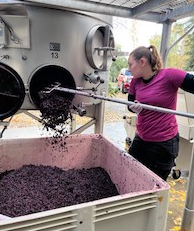 When asked what she most loved about her involvement as a next-generation family member, Colleen responded: "Someday I will be the head of all this. I love sharing the family story. People are in awe of the winery and our family's spectacular vineyard, and I am part of that family story."
When asked what she most loved about her involvement as a next-generation family member, Colleen responded: "Someday I will be the head of all this. I love sharing the family story. People are in awe of the winery and our family's spectacular vineyard, and I am part of that family story."(Lena at work in the cellar)
The jury is still out on whether her younger daughter, Lena, a recent UC Santa Barbara graduate in environmental science, will represent the third generation. She worked two summers in the vineyard with her grandfather and participated in the most recent harvest. She is currently employed at the winery in administration.
Considerations for a Generational Transition. Jerry finds the Valley a very different place today than in the 1970s and 1980s, when "owners and winemakers had an open door and were willing to help." As one example, Al Brounstein, the founder of Diamond Creek Vineyards, gave Jerry his book of contacts to assist him in selling his wine. Brounstein had a small, estate-grown winery, with strong emotional ties to his vineyards. "The situation is much different and more competitive today." Many of today's owners in the valley do not involve themselves in the vineyards and farming aspects of a winery.
He believes the next generation needs to be prepared and ready to handle the ups and downs of business cycles, weather, etc. He recommends looking long term, having a strong ego, and engendering love with what you are doing: "There are few more creative activities, and dedication is required."
Finally, one needs several years of hands-on experience from working with one's own family winery or elsewhere before agreeing to a transition, as well as good family relations and thoughtful estate planning.
Delia Viader and son Alan, VIADER (Howell Mountain)
"VIADER will always continue because of the terroir here." Alan Viader
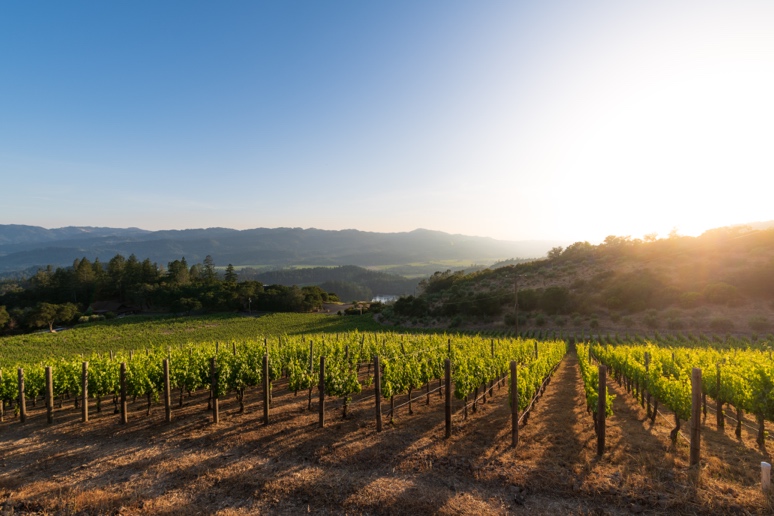 Born in Argentina, Delia Viader has a French connection—her father was a diplomat in France and fond of fine wine. She came to the U.S., a single parent with three young children, to study business at MIT. She had completed a Doctorate in Philosophy from the Sorbonne in Paris earlier and had plans to start her own business, which her father supported.
Born in Argentina, Delia Viader has a French connection—her father was a diplomat in France and fond of fine wine. She came to the U.S., a single parent with three young children, to study business at MIT. She had completed a Doctorate in Philosophy from the Sorbonne in Paris earlier and had plans to start her own business, which her father supported. Pursuing this goal, Delia purchased acreage on Howell Mountain in the Napa Valley in the early 1980s. She founded VIADER Vineyards & Winery in 1986 and released her first vintage the next year. With a St. Emilion-style blend in mind, she used a Bordeaux style of vineyard cultivation to plant a 23-acre vineyard of Cabernet Sauvignon and Cabernet Franc, planting the vines in rows going up and down the steep slope rather than perpendicular to it. The rows follow the east–west path of the sun down the slopes of Howell Mountain as a result. Delia's theory was that the combination of optimal sun exposure, close spacing between vines and rows, and the vineyard's unique rocky terroir, which allows for natural drainage, would force the vines to struggle to survive and produce fruit of exceptional quality.
Although controversial at the time, her theory has been well supported by critics' ratings and reviewers of her wines. The 1989 VIADER Proprietary blend of Cabernet Franc and Cabernet Sauvignon is now its signature wine. Both the 1997 and 1998 VIADER Napa Valley wines were included among Wine Spectator's Top Ten Wines in 2000 and 2001. Similarly, the 2019 VIADER Napa Valley received high praise across the board, including from Owen Bargreen (score of 98), who commented that "If you love Napa with terroir and balance, do not look any further." Other limited production wines include DARE by VIADER and Homenaje by VIADER crafted in honor of Delia's father, who was instrumental in the origin of the winery.
The current production at the winery is 1500 cases, lower than previous years due to the 2020 Glass fire. The vineyards are certified organic (CCOF), and VIADER was certified as a Napa Green Winery in 2017. A separate certification earned in 2018, Napa Green Land, highlights the Viaders' focus on sustainable farming. The winery is vertically integrated as well.
The Family and Its Generational Transition. We met with Delia and Alan in the winery's elegant tasting room that overlooks their dramatic vineyards. Delia noted that her family and her fascination with fine wines were her primary motivations for the property's location. She made a conscious decision to build her home close to the vineyards so that her children would grow up in close proximity to the vineyards and could be involved. "I did not want to straitjacket them, but I purposely provided ways for them to be engaged. I also gave them agency."
Alan is a person of quiet intensity and great curiosity who loves what he does and welcomes being challenged and learning. He grew up "focused on the farming." The production side of the winery did not appeal to him until his early 20s. After high school, he enrolled in a hands-on viticulture management program at Santa Rosa Junior College, earning his associates degree in 2001. He came on board to manage the winery's vineyards the next year.
Delia had hoped with time that Alan would embrace winemaking as well, and he did. Alan stepped into the lead winemaking role in 2006, at the age of 25. He first had enrolled in courses at UC Davis, traveled to major wine regions, and worked internationally doing harvest internships in Mendoza and studying at Bordeaux Sciences Agro at the University of Bordeaux with Professor Kees Van Leeuwen who conducts research on the concept of terroir in viticulture. Michel Rolland, a family friend and global winemaking consultant, provided Alan with important international perspectives.
Since then, he has earned an undergraduate degree and an MBA in wine business and completed the Wine Executive Program at UC Davis. Curious about emerging techniques, experimentation, and working with new varietals, he makes it a point to attend wine-related seminars offered by UC Davis.
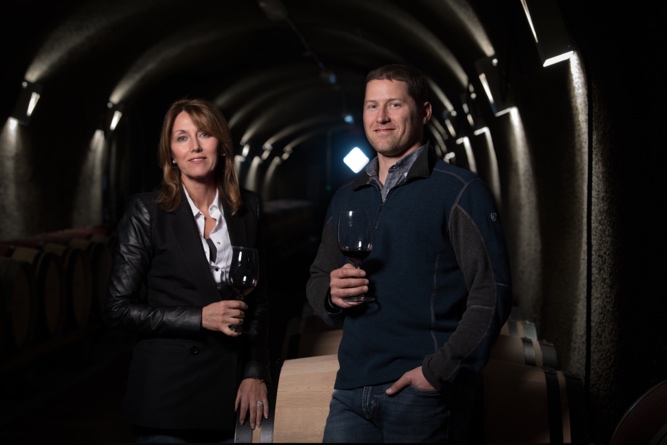 When we asked Alan if there were "aha moments" that reinforced his love for wine and his chosen career path, he mentioned three. One was starting to like wine after tasting the 1999 vintage of VIADER (the 1999 VIADER Napa Valley was listed among Wine Spectator's Top 100 Wines in 2002. Another was working at Bodega Achaval Ferrer, one of Argentina's leading wineries, in 2005. Alan said that he "was totally focused on winemaking and asked tons of questions about farming and the importance of terroir." He came home with a deeper understanding of terroir and its relationship to the finished product. Importantly, he now knew that winemaking was his calling.
When we asked Alan if there were "aha moments" that reinforced his love for wine and his chosen career path, he mentioned three. One was starting to like wine after tasting the 1999 vintage of VIADER (the 1999 VIADER Napa Valley was listed among Wine Spectator's Top 100 Wines in 2002. Another was working at Bodega Achaval Ferrer, one of Argentina's leading wineries, in 2005. Alan said that he "was totally focused on winemaking and asked tons of questions about farming and the importance of terroir." He came home with a deeper understanding of terroir and its relationship to the finished product. Importantly, he now knew that winemaking was his calling.(Delia and son Alan)
The third "moment" was more about the lifestyle he has embraced—he recalled rushing to attend a high-end party in a tuxedo, and someone at the event commenting on his red-wine-stained "dirty" hands. Alan smiled as he reflected on how well this image captures the life he loves.
When asked what he most loved about his involvement as a second-generation family member, Alan said, "It is always like a relay race, and you don't want to drop the baton." Alan cares deeply about preserving the land for future generations and preserving the family business for the next generation. He feels that he and Delia want to get to the same finish line, and added that at times working for one's parent can be challenging—"both your heart and mind must truly be in it."
Third-generation involvement looks promising. Alan and his spouse Mariela have three children, ages, 9, 12, and 14. All the children engage in some way with the farming.
Given his concern for the environment, Alan is a first responder and trained volunteer firefighter, an important skill in fire-prone California. He was named 2023 Firefighter of the Year by Napa County Fire, Deer Park Station. He founded Intentus in 2020 to craft wines whose sales would provide charitable giving to organizations supporting communities in need and the brave first responders who put themselves on the frontlines.
Considerations in Planning for a Generational Transition. Delia and Alan noted that a successful transition plan involved developing a good business plan, engaging children in the love of farming early on, giving them agency to create or modify their own roles, and possessing love for what you do. Because the sense of family "legacy" can fade from one generation to the next, keeping up the family ties and good relations are of great importance.
Another consideration is the reality of the difference between a generational transition and starting a new winery. Alan noted that there is no way he could start a winery today as Delia had done in the early 1980s. A myriad of new regulations, the 3 to 7 years needed to address them in the Napa Valley, and the costs to do so are considerable. Moreover, the cost for land suitable for vineyards is prohibitive unless the property is inherited.
Reflections on Our Conversations
Family businesses can be complicated, and engaging in generational transitions is perhaps even more complicated. Contrary to popular lore, however, family businesses tend to endure well beyond the second or third generation. According to Josh Baron and Rob Lachenauer's article in the Harvard Business Review, "family businesses last far longer than typical companies do and are well-positioned to remain competitive in the 21st century economy." A key aspect of their greater competitiveness has to do with the "family" aspect of a small family business, a theme that resonated in our conversations.
Commonalities. Though each family has its own unique history and generational transition, there were commonalities:
-solid estate and financial planning, and minimal borrowing;
-strong emotional and financial ties to the vineyards;
-passion for caring for the land and farming, and modeling this passion to one's children—"both your heart and mind must truly be in it;"
-continual focus on what you are known for, what you do well, and taking a long-term perspective;
-respect for parents/grandparents and what they have created;
-good family relationships and ability to engage in effective communication;
-freedom for children to find their own way, including a college education and time away from home;
-children having the passion, interest, and ability/skills, including hands-on experience, to build on the previous generation's foundation;
-clear roles for children in the family business, associated with agency and room to contribute.
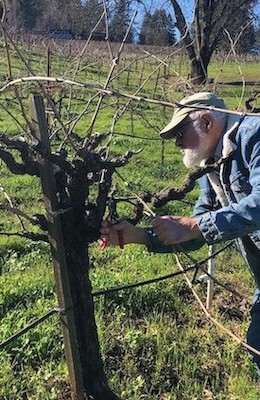 Needless to say, there are continuing challenges as a family winery evolves from one generation to the next. Passion for the hard work and the uncertainties associated with the viticulture, vinification, and sales will likely vary with successive generations. Love for the land, and the mentoring and wisdom provided by parents and grandparents, however, will likely be key to their enduring future.
Needless to say, there are continuing challenges as a family winery evolves from one generation to the next. Passion for the hard work and the uncertainties associated with the viticulture, vinification, and sales will likely vary with successive generations. Love for the land, and the mentoring and wisdom provided by parents and grandparents, however, will likely be key to their enduring future.(Jerry Seps getting his hands and boots dirty)
Children's Career Pathways. Philip Togni noted through his "four pillars cautionary tale" that one cannot force offspring to be interested in farming and joining the family business. John Buehler, interestingly, put his faith in the "DNA" created with growing up on beautiful farming properties and seeing parents caring for the land. He believes that children need time away to explore their own passions, and, under the right conditions, the DNA, or deeply planted seeds, will become manifest.
We saw some evidence of John's theory in the next generation pathways of these six families—for the Corison/Martin family's daughters, it was the pandemic, for the Dunn family perhaps the sudden loss of a dear child and sister, for Lisa Togni, and to some degree, Alan Viader, experiences working harvests and studying in international wine regions, and for Colleen Seps, a comfort and ability to do what was needed when unexpected vacancies at her father's winery occurred.
Ongoing Challenges. There were also commonalities in concerns raised in the conversations, particularly the influx of outside money, corporate and private. Jerry Seps noted that many of today's owners in the valley do not involve themselves in the vineyards and farming aspects of a winery. Jancis Robinson described these concerns in a recent article. She explained that rather than embracing farming, which involves a constant battle with nature, a typical tech billionaire who wants to add to Napa Valley's 1,000-plus wine brands is more likely to engage in a battle with wine critics. Their focus is on how to get a 100-point score in as short a time as possible. "And if they own vines, the odds are they will hire a vineyard management company so they may never actually get their boots dirty."
Next-generation small family wineries, including those families with whom we met, play a crucial role in providing a barrier/moderator/limit on the influx of big money—they produce the quality wine and own their vineyard and winery. Joel Peterson, Ravenwood's founder, commented at a recent event:
"You've got some of the creme de la creme at California small wineries with really dedicated, really strong winemakers who love what they do. And it shows. And they love the vineyards. They work in these vineyards. And they spend a lot of time in the vines. And ultimately, when it comes down to the wine, the core value is the vineyard you make it from."
These families also contribute through their organic vineyard practices and their focus on what they will leave behind for the next generation, whether through regenerative and/or organic farming, working with like-minded organizations, or gifting to the Napa Land Trust.
Closing Remarks
Our conversations with these six families left us totally impressed by and in awe of the passionate families who helped make the Napa Valley famous for its great wineries. Despite all the doom and gloom of what is perceived as happening in Napa these days, we have complete confidence in the wisdom and abilities of this next generation. At least among these six families, quite equally represented by capable women and men, they are preserving their land for future generations and ensuring continuation of their family business for the next generation.
Notes
In addition to our in-person conversations with each family we gathered information from the Napa Wine Project, books by Gordon (2010), Laube (2007), Pinney (2012), and Robinson & Murphy (2013), winery websites, and other publicly available sources.
1. Napa Valley wineries no longer family-owned by a founding family include those having a publicly traded parent company (e.g., Constellation, Duckhorn Portfolio, LVMH) or owned by another entity (e.g., Artemis Group, Boisset Family Estates, GI Partners, Lawrence Wine Estates, E. & J. Gallo, Jackson Family Wines, private equity groups.)
Author Bios: Lucia Albino Gilbert, Ph.D., and John C. (Jack) Gilbert, Ph.D., both Professors Emeriti, have had long and distinguished careers at The University of Texas at Austin and Santa Clara University and are widely published in their fields. Their research on different aspects of California's wine industry and its leading wineries and winemakers combines Lucia's academic field of Psychology and John's academic field of Organic Chemistry. The acclaimed book, Women Winemakers: Personal Odysseys, is among their recent publications. They can be reached at [email protected]. Their research website is www.womenwinemakers.com.
